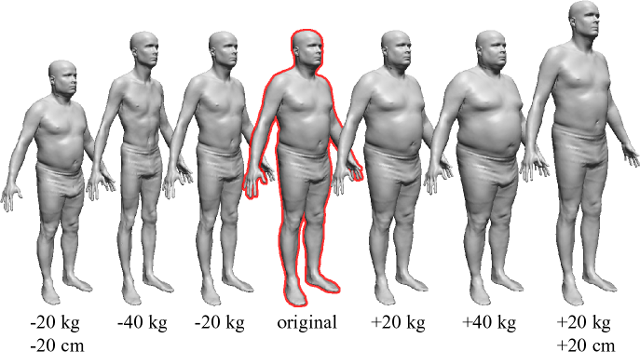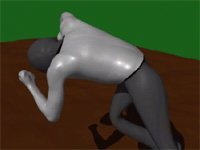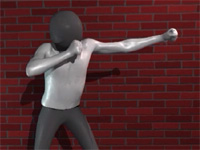University of Washington /
Department of Computer Science and Engineering /
GRAIL /
Projects
Digital Humans
Introduction
The goal of this project is to create the appearance of realistic human
characters. This task can be broken down into many subproblems:
animation, body shape, surface appearance, etc. So far, most of our
work has focused on the body shape subproblem; specifically, how to use
data from 3D scanners to create models of human body shape.
Project members
Body Deformations
 As the body moves, its shape changes in complex ways, due to the
contraction and relaxation of muscles, bones visible beneath the skin,
and various other anatomical features. Often this variation is modelled
either by artists using various varieties of deformers, or by anatomical
modeling and simulation of the bodily structures involved. Instead, we
take an example-based approach, where we
build a model of these shape changes using 3D laser range scans of a body
in various poses.
As the body moves, its shape changes in complex ways, due to the
contraction and relaxation of muscles, bones visible beneath the skin,
and various other anatomical features. Often this variation is modelled
either by artists using various varieties of deformers, or by anatomical
modeling and simulation of the bodily structures involved. Instead, we
take an example-based approach, where we
build a model of these shape changes using 3D laser range scans of a body
in various poses.
We scanned an arm, shoulder, and torso in many
different poses, a few of which are shown on the left. We then
combined these scans into a common parameterization, so that the
shape of the body in any pose can be estimated using scattered
data interpolation techniques.
Shown below are a few videos of our model, driven by motion capture
data:
The details of our parameterization and interpolation techniques are described in our
SIGGRAPH 2002 paper.
Body Variation
In addition, we also wish to model how body shape varies between individuals.
To this end, we used 250 laser range scans of volunteers in approximately the
same pose. We developed an algorithm to fit a common template to each range
scan in order to create a common parameterization of the body surface. This
allows us to morph between body shapes as shown below:

More significantly, our common parameterization also enables us to analyze the
variation in body shape, using techniques such as principle component analysis.
One possible application is to use the learned distribution of shapes to synthesize
new, random individuals. In the figure above, the individuals outlined in red
were randomly generated.
Another application is to relate known characteristics of the scanned individual
to body shape. For example, we can learn a simple model of how body shape varies
with respect to height and weight, and use this to edit an individual, such as the
man outlined in red below:

The details of our correspondence algorithm and applications are in our
SIGGRAPH 2003 paper.
Publications
-
ALLEN, B., CURLESS, B., POPOVIĆ, Z., and HERTZMANN, A.
2006. Learning a correlated model of identity and pose-dependent
body shape variation for real-time synthesis. In
Proc. of the 2006 ACM SIGGRAPH/Eurographics symposium on Computer animation, p. 147-156, Sept. 2-4, Vienna, Austria.
[PDF;
paper details]
- ALLEN, B., CURLESS, B., and
POPOVIĆ, Z. 2004. Exploring the space of human
body shapes: data-driven synthesis under anthropometric control. In
Proc. Digital Human Modeling for Design and Engineering
Conference, Rochester, MI, June 15-17. SAE International.
[PDF;
paper details]
- ALLEN, B., CURLESS, B.,
and POPOVIĆ, Z. 2003. The space of all
body shapes: reconstruction and parameterization from range scans.
ACM Transactions on Graphics (ACM SIGGRAPH 2003), 22, 3, 587-594.
[PDF;
paper details]
- ALLEN, B., CURLESS, B., and POPOVIĆ, Z. 2002.
Articulated body defromation from range scan data.
ACM Transactions on Graphics (ACM SIGGRAPH 2002),
21, 3, 612-619.
[PDF;
paper details]
Data
The arm dataset
from our SIGGRAPH 2002 paper on pose pose variation is available online.
Support
This research is supported by:
 As the body moves, its shape changes in complex ways, due to the
contraction and relaxation of muscles, bones visible beneath the skin,
and various other anatomical features. Often this variation is modelled
either by artists using various varieties of deformers, or by anatomical
modeling and simulation of the bodily structures involved. Instead, we
take an example-based approach, where we
build a model of these shape changes using 3D laser range scans of a body
in various poses.
As the body moves, its shape changes in complex ways, due to the
contraction and relaxation of muscles, bones visible beneath the skin,
and various other anatomical features. Often this variation is modelled
either by artists using various varieties of deformers, or by anatomical
modeling and simulation of the bodily structures involved. Instead, we
take an example-based approach, where we
build a model of these shape changes using 3D laser range scans of a body
in various poses.




